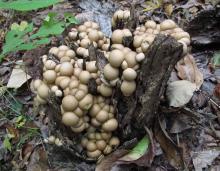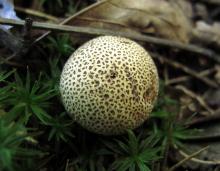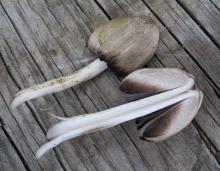Mushrooms
Media

Species Types
Scientific Name
Hericium coralloides (formerly H. ramosum)
Description
The comb tooth is a branched, whitish mass on fallen logs and decaying deciduous trees. Its branches are covered with tufts of hanging, toothlike spines.
Media

Species Types
Scientific Name
Polyporus radicatus
Description
The rooting polypore has a scruffy, tough, yellowish-brown cap with whitish-yellow pores, and a stalk with a long, black, rootlike filament. It usually grows singly, on the ground near stumps or attached to buried roots.
Media

Species Types
Scientific Name
Lycoperdon pyriforme (Morganella pyriformis)
Description
This is a pear-shaped, yellowish brownish puffball with a pore at the top. Pear-shaped puffballs typically grow in large clusters on decaying wood, logs, and stumps.
Media

Species Types
Scientific Name
Scleroderma citrinum (Scleroderma aurantium)
Description
The pigskin puffball is a rounded, warted, yellowish brown ball with blackish purple flesh. It grows on the ground, on wood debris, and near trees in woods.
Media

Species Types
Scientific Name
Tylopilus felleus
Description
The bitter bolete has a large, tannish brown cap with pinkish white pores and a webbed, tannish brown stalk. It grows singly or scattered on the ground in mixed woods.
Media

Species Types
Scientific Name
Amanita thiersii
Description
Thiers amanita has a white, gilled cap, and the stem is large, white, sticky, and shaggy. It grows in lawns, pastures, and prairies, often in fairy rings.
Media

Species Types
Scientific Name
Coprinopsis atramentaria (formerly Coprinus atramentarius)
Description
The alcohol inky has a gray-brown, bell-shaped, radially lined cap and inky gills. It grows in clusters on the ground, usually near rotting or buried wood.
Media

Species Types
Scientific Name
Amanita spp. (about 600 species, worldwide)
Description
This large group of mushrooms accounts for 90 percent of mushroom-related deaths, so every mushroom hunter should be familiar with amanitas. They contain one of the deadliest poisons found in nature!
Media

Species Types
Scientific Name
Gymnopilus junonius (formerly G. spectabilis)
Description
Big laughing gym mushrooms are large, orangish yellow, and have a ring on the stalk. They grow in clusters on stumps and trunks of deciduous trees, on the ground, or over buried wood.
Media

Species Types
Scientific Name
Lepista nuda (Clitocybe nuda; Tricholoma nudum)
Description
The blewit grows scattered in open areas, in mulch piles, and along paths. All parts of this mushroom—cap, gills and stalk—are violet to tan.
See Also



Media

Species Types
Scientific Name
Monotropa hypopitys
Description
Pinesap is a plant that puts the "wild" in wildflower! It lacks chlorophyll, so its roots connect to fungi underground and absorb nutrients from the fungi.
Media

Species Types
Scientific Name
Cladophora, Pithophora, and Spirogyra spp., and others
Description
Filamentous green algae forms green, cottony masses that are free-floating or attached to rocks, debris, or other plants.
Media

Species Types
Scientific Name
Monotropa uniflora
Description
Indian pipe lacks chlorophyll, so it is white, not green. Below ground, its roots join with fungi that connect to tree roots. This plant, then, takes nourishment indirectly from the trees.
About Mushrooms in Missouri
Mushrooms are a lot like plants, but they lack chlorophyll and have to take nutrients from other materials. Mushrooms are neither plants nor animals. They are in a different kingdom — the fungi. Fungi include the familiar mushroom-forming species, plus the yeasts, molds, smuts, and rusts.
Always be cautious when eating edible mushrooms. Be absolutely sure of the ID, and only eat a small amount the first time you try it to avoid a reaction..





















